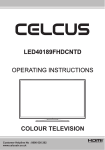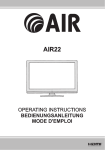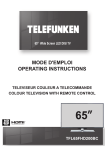Download Finlux 47S9100-T User's Manual
Transcript
happy Finnish 47in 3D LED TV 47S9100-T Owner’s manual Customer Helpline Number: 0845 459 5282 Contents Environmental Information ..................................... 2 Digital Teletext....................................................... 23 Accessories included............................................... 3 Software Upgrade................................................. 23 TV - Features ......................................................... 3 Troubleshooting & Tips.......................................... 24 Safety Precautions and Important Information........ 3 Licence Notifications............................................. 24 Viewing the TV ....................................................... 4 Appendix A: Nero MediaHome Installation............ 25 TV Control Buttons & Operation.............................. 4 Appendix B: PC Input Typical Display Modes....... 26 Operation with the Buttons on the TV...................... 4 Appendix C: AV and HDMI Signal Compatibility (Input Signal Types)............................................... 26 Operation with the Remote Control......................... 4 Remote Control ...................................................... 5 Appendix D: Supported File Formats for USB Media Browser................................................................. 27 Remote Control ...................................................... 6 Appendix E: Supported DVI Resolutions............... 28 Inserting the Batteries into the Remote Control...... 8 SKY Remote Control Code.................................... 28 Connect Power & Antenna...................................... 8 Specifications........................................................ 28 Switching On/Off...................................................... 8 First Time Installation.............................................. 8 Media Playback via USB Input................................ 9 Quick Menu........................................................... 10 Changing Image Size: Picture Formats................. 10 Using the Channel List.......................................... 10 Menu Features and Functions................................11 Electronic Programme Guide (EPG)..................... 14 Recording a Programme....................................... 14 Timeshift Recording .............................................. 15 Instant Recording.................................................. 15 Watching Recorded Programmes ........................ 15 Recording Configuration........................................ 15 Product Safety....................................................... 15 Health Warning! - 3D Mode................................... 16 Using the 3D Mode................................................ 16 Setting up 3D Mode for PS3.................................. 17 Setting up 3D Mode for Sky HD............................ 17 3D Settings............................................................ 17 3D Viewing Information......................................... 18 Wired Connectivity................................................ 19 Wireless Connectivity ........................................... 20 Other Information.................................................. 21 Connectivity Troubleshooting................................ 21 DLNA .................................................................... 22 Internet Portal........................................................ 23 iPlayer Application................................................. 23 English - 1 - Power cord and plug Screen •The power cord plug should be easily accessible. If there is lightning or storms, or if the TV is not going to be used for a while (e.g. if going away on holiday), disconnect the TV set from the mains. •Occasionally, a few non-active pixels may appear on the screen as a fixed blue, green or red point. Please note that this does not affect the performance of your product. •Do not place the TV, furniture, etc. on the power cord or pinch the cord. •Take care not to scratch the screen with fingernails or other hard objects. •Handle the power cord by the plug, do not unplug the TV by pulling the power cord. Cleaning •Never touch the power cord/plug with wet hands as this could cause a short circuit or electric shock. •Never make a knot in the power cord or tie it with other cords. •Power cords should be placed in such a way that they are not likely to be stepped on or provide a trip hazard. •A damaged power cord/plug can cause fire or give you an electric shock. When damaged it must be replaced, this should only be done by qualified personnel. Moisture and Water •Do not use this TV in a humid or damp place (avoid using in the bathroom or near the kitchen sink) •Do not expose this TV to rain or water, as this may be dangerous. •If any solid object or liquid falls into the cabinet, unplug the TV and have it checked by qualified personnel before operating it any further. Ventilation •The slots and openings on the TV set are intended for ventilation and to ensure reliable operation. •To prevent overheating, these openings must not be blocked or covered in any way. Heat sources and Flames •Do not expose the TV to direct sunlight or other heat sources. •The TV should not be placed near open flames or sources of intense heat such as an electric heater. •Ensure that no open flame sources, such as lit candles, are placed on top of the TV. Headphone Volume •Excessive sound pressure from earphones and headphones can cause hearing loss, please take care. Wall Mounting (optional) •To prevent injury, this TV must be securely attached to the wall in accordance with the installation instructions. •Before cleaning, unplug the TV from the wall socket. •Do not use liquid or aerosol cleaners. Only use a soft, dry cloth. Environmental Information This television is designed to consume less energy to help save the environment. You can not only help to save the environment but you can also save money by reducing your electricity bills thanks to the energy efficiency features of this TV. To reduce energy consumption, you should take the following steps: You can use the Power Save Mode setting, located in the Picture menu. If you set the Power Save Mode as Eco, the TV will switch to energy-saving mode and the luminance level of TV set will be decreased to the optimum level. Note that some picture settings will be unavailable to be changed when the TV is in Power Save Mode. If Picture Off is selected, “Screen will be off in 15 seconds.” message will be displayed on the screen. Select PROCEED and press OK to continue. The screen will be off in 15 seconds. When the TV is not in use, please switch off or disconnect the TV from the mains plug. This will also reduce energy consumption. It is highly recommended that you activate the Power Save Mode setting to reduce your annual power consumption. 1) If the TV does not receive any input signal (e.g. from an aerial or HDMI source) for 5 minutes, the TV will go into standby. When you next switch-on, the following message will be displayed: “Standby Cause No Signal” Press OK to continue. 2) If the TV has been left on and not been operated for 4 hours, the TV will go into standby. When you next switch-on, the following message will be displayed. “Standby Cause No Operation” Press OK to continue. English - 2 - Accessories included Safety Precautions and Important Information Remote Control x 2 Batteries: 2 x AAA Please read these instructions fully before installing or operating. Instruction Book Side AV Connection Cable Preparation WiFi Dongle USB Cable NeroHome Media CD 3D Glasses x 8 TV - Features •3D Viewing: This product supports the viewing of 3D content from devices such as a High Definition Satellite Receiver or Blu-ray Player via the HDMI input. •Remote controlled colour LCD TV •Fully integrated digital tuner •DVB-T2 Compliant •HDMI Inputs are for connecting a device that has a HDMI socket •USB input •10000 programmes •OSD menu system •Scart socket for external devices (such as DVD Players, PVR, video games, etc.) •Stereo sound system •Teletext •Automatic programming system •Manual tuning •Automatic power down after up to six hours •Sleep timer •Child lock WARNING: Never let people (including children) with reduced physical, sensory or mental capabilities or lack of experience and / or knowledge use electrical devices unsupervised. •The TV should be operated only from a 220-240 V AC, 50 Hz outlet. •NTSC playback •AVL (Automatic Volume Limiting) Positioning the TV •PLL (Frequency Search) •PC input •Plug&Play for Windows 98, ME, 2000, XP, Vista, Windows 7 •802.11n WiFi Support via USB dongle This device is used to receive and display TV programmmes. The different connection options expand the reception and display sources possible (various external devices). This device is only suitable for operation in dry interiors. This appliance is intended solely for private domestic use and may not be used for industrial and commercial purposes. We exclude liability in principle, if the device is not used as intended, or unauthorized modifications have been made. To operate your TV in extreme ambient conditions may cause damage to the device. Power source •Automatic sound mute when no transmission •Ethernet (LAN) for Internet connectivity Intended Use Children may not recognize the dangers of incorrect use. The swallowing of batteries can be fatal. Keep batteries out of reach of small children. If a battery is swallowed, immediately seek medical attention. Keep the packaging films out of reach of children to prevent the risk of suffocation. •Headphone connection •Game Mode (optional) Place the device on a solid even surface. For ventilation purposes, leave a free space of at least 10 cm all around the set. Do not place any objects on top of the set. Use this device in moderate climates. Operation temperature and operation humidity: 5ºC up to 45ºC, 85% humidity max. Note: Don’t block ventilation holes. •For ventilation, please leave a clear space of at least 10cm all around the TV. •Do not block the ventilation openings. •Do not place the TV on sloping or unstable surfaces, the TV may tip over. •To prevent damage to the TV, do not place any objects on top of the TV. •DLNA •100Hz frequency scan English - 3 - Operation with the Buttons on the TV Viewing the TV Press button to decrease volume or button to increase volume. Press P/CH + button to select the next programme or P/CH - button to select the previous programme. Press the or button at the same time to view main menu. In the Main menu select sub-menu using TV/AV button and set the submenu using or buttons. To see what options are available via the menu, refer to the menu system section of this manual. Press the TV/AV button in the control panel on the TV to switch between AV modes. TV Control Buttons & Operation Note: Function indications of the buttons will be displayed on the screen when pressed. Operation with the Remote Control TV/AV Press the MENU button on your remote control to display the main menu screen. Use the “ ” or “ ” buttons to select a menu tab and press the OK button to select option. Use the “ ” / “ ” or “ ” / “ ” buttons to select or set an item. Press BACK or EXIT or MENU button to quit a menu screen. MENU P/CH Input Selection Once you have connected external systems to your TV, you can switch to different input sources. Press the “ - (SOURCE)” button on your remote control consecutively to select the different inputs. 1. Standby/On button Changing Channels and Volume 2. TV/AV button You can change the channel and adjust the volume using the V+/- and P+/- buttons on the remote. 3. Programme Up/Down buttons 4. Volume Up/Down buttons English - 4 - Remote Control 1. Standby / On 2. Channel list 3. Volume up-down 4. Menu on/off 5. OK / Channel list / Confirm 6. Return / Back 7. Internet Portal 8. My button 1 / Youtube (*) 9. My button 2 (**) 10. Coloured buttons (Red, Green, Yellow, Blue) TV 11. Mono-Stereo Dual I-II / Current language 12. Fast rewind (in media browser mode) 13. Pause (in media browser mode) / Timeshift recording 14. Programme recording 15. Play (in media browser mode) 16. Stop (in media browser mode) 17. Fast forward (in media browser mode) 18. Subtitle on-off / Subtitle (in media browser mode) 19. Image size 20. Teletext - Mix 21. Media Browser 22. Electronic programme guide 23. Exit 24. Navigation buttons 25. Quick menu 26. Info / Reveal (in TXT mode) 27. Programme up/down 28. Mute 29. Previous programme / Now (in EPG mode) 30. Numeric buttons 31. AV / Source NOTE: The Remote Control range is approximately 7m / 23ft. Using My button 1 (*) Using My Button 2 (**) This button’s main function is to run Youtube link. However, if you want to change this function, you can press MY BUTTON 1 for five seconds when on a desired source, channel or link, until the “MY BUTTON IS SET” message is displayed on the screen. This confirms that the selected MY BUTTON is now associated with the selected function. Note that if you perform first time installation, MY BUTTON 1 will return to its default function. This button’s main function is to switch to DVB-T, broadcasts. However, if you press MY BUTTON 2 for five seconds, you can set a function to it as described in My Button 1. Note that if you perform a first time installation, MY BUTTON 2 will return to its default function. English - 5 - Remote Control 1. Standby / On 2. Volume up/down 3. Source selection 4. Info 5. Mute 6. Programme up/down 7. Image size 8. Mono-Stereo Dual-II / Audio-Subtitle language English - 6 - Connections Connector Type Cables Device Scart Connection (back) AUDIO L&R VGA Connection (back) PC/YPbPr Audio Connection (back) HDMI Connection (back & side) S/PDIF Optical Out (back) SIDE AV Side AV Connection (side) HEADPHONE Headphone Connection (side) YPBPR S/PDIF YPbPr Video Connection (back) AV Connection Cable (supplied) USB Connection (side) CI Connection (side) CAM module Subwoofer Connection (back) NOTE: When connecting a device via the YPbPr or Side AV input, you must use the supplied connection cables to enable connection. See the illustrations above. | To enable PC audio, you will need to use the PC/YPBPR AUDIO CONNECTION cable’s WHITE & RED inputs. | If an external device is connected via the SCART socket, the TV will automatically switch to AV mode.| When receiving DTV channels (Mpeg4 H.264) or while in Media Browser mode, output will not be available via the scart socket. | When using the wall mounting kit (optional), we recommend that you plug all your cables into the back of the TV before mounting on the wall. | Insert or remove the CI module only when the TV is SWITCHED OFF. You should refer to the module instruction manual for details of the settings. English - 7 - Inserting the Batteriesinto theRemote Control 1. Lift the cover on the back of the remote upward gently. 2. Install two AAA batteries. Make sure to match the + and - ends of the batteries in the battery compartment (observe the correct polarity). First Time Installation When turned on for the first time, the “language selection” menu appears. The message “Welcome please select your language!” is displayed and all language options are listed alphabetically. 3. Replace the cover. Connect Power & Antenna HDMI 1 HDMI 2 IMPORTANT: The TV set is designed to operate on 220-240V AC, 50 Hz socket. After unpacking, allow the TV set to reach the ambient room temperature before you connect the set to the mains. Plug the aerial cable into the ANT socket on your TV. SPDIF Press the “ ” or “ ” button to highlight the required language, press OK button to select. “First Time Installation” appears. Use “ ” or “ ” button to set the required country, and press “ ” button to select Search Type. Use “ ” or “ ” to set the desired search type. Available search types are digital and analog, digital only and analog only. When set, press “ ” to select Teletext Language. Use “ ” or “ ” button to set the “Teletext Language” and select “Scan Encrypted” using “ ” or “ ” button. You can set Scan Encrypted as Yes if you want to scan coded stations. Coax.OUT Switching On/Off To Switch the TV On Connect the power cord to the 220-240V AC, 50 Hz. To switch on the TV from standby mode either: Press the “ ” button, P+ / P- or a numeric button on the remote control or press the “ ” button on the TV. To Switch the TV Off Press the “ ” button on the remote control or press the “ ” button on the TV. The TV will now switch to standby mode. To power down the TV completely, unplug the power cord from the mains socket. Note: When the TV is switched to standby mode, the standby LED can blink to indicate that features such as Standby Search, Over Air Download or Timer is active. The LED can also blink when you switch on the TV from standby mode. Press OK button on the remote control to continue and the following message will be displayed on the screen. English - 8 - You can activate Store mode option by using “ ” or “ ” button. If Store Mode is selected, Store mode option will be available in “Other settings” menu and your TV’s settings will be optimized for best display quality. A confirmation screen will be displayed after selecting the Store Mode. Select YES to proceed. If Home Mode is selected, Store mode will not be available after the First Time Installation. Press OK button on the remote control to continue and the following message will be displayed on the screen. You must select YES to search and store broadcasts. The television will search for digital terrestrial TV broadcasts. Media Playback via USB Input You can connect a USB hard disk drive or USB memory stick to your TV by using the USB inputs of the TV. This feature allows you to play files stored in a USB drive. 2.5” and 3.5” inch (hdd with external power supply) external hard disk drives are supported. IMPORTANT! You should back up your files before making any connections to the TV set in order to avoid any possible data loss. The Manufacturer will not be responsible for any file damage or data loss. It is possible that certain types of USB devices (e.g. MP3 Players) or USB hard disk drives/memory sticks may not be compatible with this TV. The TV supports FAT32 and NTFS disk formatting but recording will not be available with NTFS formatted disks. Note: While formatting a USB hard disk that has 1TB (Tera Byte) or more file capacity, you can experience problems with the formatting process. Quickly plugging and unplugging USB devices is a very hazardous operation. This may cause physical damage to the USB player and the USB device itself. Do not pull out the USB module while playing a file. Media Browser Menu NOTE: You can press MENU button to cancel. After all the available stations are stored, the Channel List will be displayed on the screen. If you are satisfied with the order of channels press the OK button to quit the channel list and watch TV. You can play photo, music, and movie files stored on a USB disk by connecting it to your TV. Connect a USB disk to one of the USB inputs located on the side of the TV. English - 9 - The USB selection OSD will be displayed on the screen. Press the MENU button and select the Media Browser tab by using the Left/Right and OK buttons. The Main media browser screen will be displayed. You can display the approprite content by selecting the Video, Music or Picture tab. Follow the button indications under each on screen menu for media playback features. Pressing the MENU button while in the Media Browser mode will access the Picture, Sound and Settings menu options. Pressing the MENU button again will exit from this screen. Changing Image Size: Picture Formats Programmes can be watched in different picture formats, depending on the transmission received. You can change the aspect ratio (image size) of the TV for viewing the picture in different zoom modes. Press the “ SCREEN” button repeatedly to change the image size. You can shift the screen up or down by using “ ” or “ ” buttons while in 14:9 Zoom, Cinema or Subtitle. Using the Channel List You can set your Media Browser preferences by using the Settings menu. Note: If two USB devices are connected to the TV at the same time, the first USB device connected to the TV will be named USB drive 1. Select the drive by using “ ” or “ ” buttons and press OK. Quick Menu The Quick Settings menu allows you to access some options quickly. This menu includes Power Save Mode, 3D Mode, Virtual 3D, Picture Mode, Equalizer Settings, Favourites and Sleep Timer options. Press Q.MENU button on the remote control to view the quick menu. See the following chapters for details of the listed features. The TV sorts all stored stations in the Channel List. You can edit this channel list, set favourites or set active stations to be listed by using the Channel List options. Press the MENU button to view the main menu. Select the Channel List item by using Left or Right button. Press OK to view menu contents. Select Edit Channel List to manage all stored channels. Use Up or Down and OK buttons to select Edit Channel List. Press the Up or Down button to select the channel that will be processed. Press the Left or Right button to select a function on the Channel List menu. Use P+/P- buttons to move page up or down. Press MENU button to exit. Sorting Channel List You can select which broadcasts will be listed in the channel list. To display specific types of broadcast, you should use the Active channel list setting. Select the Active channel list from the Channel list menu by using “ ” or “ ” button. Press the OK button to continue. You can select a network type option from the list by using “ ” or “ ” and OK buttons. English - 10 - Menu Features and Functions Picture Menu Contents 3D Settings Press to view 3D settings. Mode You can change the picture mode to suit your preference or requirements. The Picture mode can be set to one of these options: Cinema, Game, Sport, Dynamic and Natural. Contrast Sets the lightness and darkness values of the screen. Brightness Sets the brightness value for the screen. Sharpness Sets the sharpness value for the objects displayed on the screen. Colour Sets the colour value, adjusting the colors. Power Save Mode To set the Power Save Mode as Eco, Picture Off and Disabled. See the section, “Environmental Information” in this manual for further information on the Power Save Mode. Backlight (optional) This setting controls the backlight level and it can be set to Auto, Maximum, Minimum or Eco Mode. The Backlight function will be inactive if the Power Save Mode is set to On. The Backlight cannot be activated in VGA, Media Browser mode or while the picture mode is set to Game. Noise Reduction If the broadcast signal is weak and the picture is noisy, use the Noise Reduction setting to reduce the amount of noise. Noise Reduction can be set to one of these options: Low, Medium, High or Off. Advanced Settings Dynamic Contrast You can change the contrast rate by using the dynamic contrast function. Dynamic contrast can be set to one of these options: Low, Medium, High or Off. Colour Temp Sets the desired colour tone. Picture Zoom Sets the picture size to Auto,16:9, Subtitle,14:9, 14:9 Zoom, 4:3 or Cinema. Movie Sense: Press Use “Left” / “Right” to set Movie Sense Low, Med, High or Off. While Movie Sense is active, it will optimize the TV’s video settings for motional images to acquire a better quality and readability. Movie Sense When Movie Sense option is set to Low, Med or High, Movie Sense demo option will be available. If one of these options is selected and if you press OK button, then the demo mode starts. While demo mode is active, the screen will be divided into two sections, one displaying the movie sense activity, the other displaying the normal settings for TV screen. HDMI True Black While watching from a HDMI source, this feature will be visible in the Picture Settings menu. You can use this feature to enhance the blackness in the picture. Film Mode Films are recorded at a different number of frames per second to normal television programmes. Turn this feature on when you are watching films to see the fast motion scenes clearly. Skin Tone Adjust the desired skin tone. Colour Shift Adjust the desired colour tone. RGB Gain Press OK button to edit RGB gain. You can configure the colour temperature values using the RGB Gain feature. Reset Resets the picture settings to factory default settings. Autoposition (in PC mode) Automatically optimizes the display. Press OK to optimize. H Position (in PC mode) This item shifts the image horizontally to the right hand side or left hand side of the screen. V Position (in PC mode) This item shifts the image vertically towards the top or bottom of the screen. English - 11 - Menu Features and Functions Advanced Settings Dot Clock (in PC mode) Dot Clock adjustments correct the interference that appear as vertical banding in dot intensive presentations like spreadsheets or paragraphs or text in smaller fonts. Phase (in PC mode) Depending on the resolution and scan frequency that you input to the TV set, you may see a hazy or noisy picture on the screen. In such a case you can use this item to get a clear picture by using trial and error. While in VGA (PC) mode, some items in Picture menu will be unavailable. Instead, VGA mode settings will be added to the Picture Settings while in PC mode. Sound Menu Contents Volume Adjusts the volume level. Equalizer In the equalizer menu, the preset can be changed to Music, Movie, Speech, Flat, Classic and User. Press the MENU button to return to the previous menu. Equalizer menu settings can be changed manually only when the Equalizer Mode is in User. Balance This setting is used for emphasizing left or right speaker balance. Headphone Sets the headphone volume. Sound Mode You can select Mono, Stereo, Dual I or Dual II mode, only if the selected channel supports that mode. AVL Automatic Volume Limiting (AVL) function sets the sound to obtain a fixed output level between programmes (For instance, volume level of advertisements tend to be louder than programmes). Headphone/Lineout (optional) When you connect an external amplifier to your TV using the headphone jack, you can select this option as Lineout. If you have connected headphones to the TV, set this option as Headphone. Dynamic Bass Enables or disables the Dynamic Bass. Surround Sound (optional) Surround sound mode can be changed as On or Off. Digital Out Sets digital audio output type. Install and Retune Menu Contents Automatic Channel Scan (Retune) Digital Aerial: Searches and stores aerial DVB stations. Manual Channel Scan This feature can be used for direct broadcast entry. Analogue Fine Tune You can use this setting for fine tuning analogue channels. This feature is not available if no analogue channels are stored. First Time Installation Deletes all stored channels and settings, resets TV to factory settings and starts first time installation. You can follow the instructions in the First Time Installations section for more information on this process. Clear Service List (*) This setting is visible only when the Country option is set to Denmark, Sweden, Norway or Finland. Use this setting to clear channels stored. English - 12 - Menu Features and Functions Settings Menu Contents Conditional Access Controls conditional access modules when available. Language Configures language settings. Parental Configures parental settings. Timers Sets timers for selected programmes. (USB Record) Recording Configuration Displays the recording configuration menu. Date/Time Sets date and time. Sources Enables or disables selected source options. Network Settings Displays network settings. Other Settings: Displays other setting options of the TV set: Menu Timeout Changes timeout duration for menu screens. Scan Encrypted When this setting is on, the search process will locate encrypted channels as well. If it is set as Off, encrypted channels will not be located in automatic or manual searches. Blue Background Activates or deactivates the blue background system when the signal is weak or absent. Software Upgrade To ensure that your TV always has the most up to date firmware. Please ensure that the TV is set to standby mode with an aerial connected to pick up the over air download. Application Version Displays application version. Hard of Hearing Enables any special feature sent from the broadcaster. Audio Description Audio description refers to an additional narration track for blind and visually impaired viewers of visual media, including television and movies. You can use this feature, only if the broadcaster supports the additional narration track. Auto TV Off You can set the timeout value of the auto off feature. After the timeout value is reached and the TV has not been operated for a selected time, the TV will go into standby mode. Standby Search (optional) If you change Standby Search to Off, this function will be unavailable. To use Standby search please make sure that you select Standby Search as On. If the Standby Search is set to On, when the TV is in standby mode, available broadcasts will be searched. If the TV locates any new or missing broadcasts, a menu screen will be displayed, asking you whether or not to execute these changes. The Channel list will be updated and changed after this process. Please activate the Standby Search setting in order to enable your TV to automatically update the broadcast frequency of the broadcaster, broadcast definition and other similar changes. Store Mode If you are displaying the TV in a store, you can activate this mode. Whilst Store Mode is enabled, some items in the TV menu may not be available. DLNA Renderer DLNA feature allows you to share files stored on your smartphone. If you have a DLNA compatible smartphone and the appropriate software is installed, you can play photos on your TV. See instructions of your sharing software for more information. Power Up Mode Virtual Remote (Optional) Standby: The TV powers up into Standby mode when the TV is plugged into the mains. Last State: The TV powers up into On mode when the TV is plugged into the mains and the last channel/source is selected. Enable or disable the virtual remote feature. English - 13 - Electronic Programme Guide (EPG) Some, but not all channels send information about the current and next programmes. Press the “ - EPG” button to view the EPG menu. Set Timer / Delete Timer After you have selected a programme in the EPG menu, press the OK button and the Options screen will be displayed. Select the “Set Timer on Event” option and press the OK button. You can set a timer for future programmes. To cancel an already set timer, highlight that programme and press the OK button. Then select “Delete Timer” option. The timer will be cancelled. Note: It is not possible to record two channels at the same time. Recording a Programme IMPORTANT: When using a new USB hard disk drive, it is recommended that you first format the disk using your TV’s “Format Disk” option. To record a programme, you should first connect a USB disk to your TV while the TV is switched off. You should then switch on the TV to enable the recording feature. Up/Down/Left/Right: Navigate EPG. OK: Displays programme options. INF(İ): Displays, in detail, information on the programme selected. GREEN: Switches to List Schedule EPG. YELLOW: Switches to Timeline Schedule EPG. BLUE: displays filtering options. (RECORD): the TV will start to record the selected progamme. You can press again to stop the recording. IMPORTANT: To record a programme, you should first connect a USB disk to your TV while the TV is switched off. You should then switch on the TV to enable the recording feature. Otherwise, the recording feature will not be available. Note: Switching to a different broadcast or source is not available during a recording. Programme Options In the EPG menu, press the OK button to enter the Event Options menu. Select Channel In the EPG menu, using this option, you can switch to the selected channel. Record / Delete Record Timer After you have selected a programme in the EPG menu, press the OK button and the Options screen will be displayed. Select the “Record” option and press the OK button. After this operation, a recording will be sheduled for the selected programme. To cancel an already set recording, highlight that programme and press the OK button and select the option “Delete Rec. Timer”. The recording will be cancelled. To use the recording function, you need to connect a USB disk or an external hard disk drive to the TV and the connected USB disk should have at least 1GB capacity and should have 2.0 speed compatibility. If the connected USB device does not support 2.0 speed, an error message will be displayed. Note: Recorded programmes are saved into the connected USB disk. If desired, you can store/copy recordings onto a computer; however, these files will not be available to be played on a computer. You can play the recordings only via your TV. Note: Lip Sync delay may occur during the timeshifting. Radio recording is not supported. The TV can record programmes up to ten hours. Recorded programmes are split into 4GB partitions. If the writing speed of the connected USB disk is not sufficient, the recording may fail and the timeshifting feature may not be available. Recordings of HD programmes can occupy more space on the USB disk compared to SD programmes. For this reason it is recommended to use a USB hard disk drive to record HD programmes. Do not unplug the USB/HDD during a recording. This may harm the connected USB/HDD. Multipartiton support is available. A maximum of two different partitions are supported. If the disk has more than two partitions, a crash may occur. The first partition of the USB disk is used for PVR ready features. It also must be formatted as the primary partition to be used for the PVR ready features. Some stream packets may not be recorded because of signal problems, so sometimes the video may freeze during playback. English - 14 - Record, Play, Pause, Display (for PlayListDialog) keys can not be used when teletext is ON. If a recording starts from the timer when teletext is ON, teletext is automatically turned off. Also teletext usage is disabled when there is an ongoing recording or playback. Timeshift Recording Press (PAUSE) button while watching a broadcast to activate timeshifting mode. In timeshifting mode, the programme is paused and simultaneously recorded to the connected USB disk. Press (PLAY) button again to resume the paused programme from where you stopped. You will see the timeshift gap between the real and the timeshifted programme in the info bar. Instant Recording Press (RECORD) button to start recording an event instantly while watching a programme. You can press (RECORD) button on the remote control again to record the next event on the EPG. In this case, the OSD will display the programmed events for recording. Press (STOP) button to cancel instant recording. Note: You can not switch broadcasts or view the Media Browser during the recording mode. Watching Recorded Programmes In the main menu, use “ ” or “ ” buttons to select the Media Browser. Highlight the Recordings Library using “ ” or “ ” button and press the OK button to enter the Recordings Library. Select a recorded item from the list (if previously recorded) by using “ ” or “ ” buttons. Press the OK button to view the Play Options. Select an option by using “ ” or “ ” or OK buttons. Press the (STOP) button to stop a playback and return to the Recordings Library. Slow Forward If you press (PAUSE) button while watching recorded programmes, the slow forward feature will be available. You can use button to slow forward. Pressing button consecutively will change slow forwarding speed. Recordings Library To view the list of recordings, select “Recordings Library” and press the OK button. The Recordings Library will then be displayed with available recordings. All the recordings are kept in a list in the recordings library. RED button (Delete) :Erases the selected recording. GREEN button (Edit): Makes changes on the selected recording. BLUE button (Sort): Changes the order of the recordings. You can select from a wide range of sorting options. OK button: Activates the play options menu: : Resume Playback. INFO (Details): Displays the programme information details. Recording Configuration Select the Recording Configuration item in the Settings menu to configure the recording settings. Format Disk: You can use the Format Disk feature for formatting the connected USB disk. IMPORTANT: Note that ALL the data stored on the USB disk will be lost and the disk format will be converted to FAT32 if you activate this feature. If your USB disk malfunctions, you can try formatting the USB disk. In most cases formatting the USB disk will restore normal operation; however, ALL the data stored on the USB disk will be lost in such a case. Note: If “USB is too slow” message is displayed on the screen while starting a recording, try restarting the recording. If you still get the same error, it is possible that your USB disk does not meet the speed requirements. Try connecting another USB disk. Product Safety Available playback options: •Play from start: Plays the recording from the beginning. •Resume: Resumes Playback from the point at which you stopped playback previously. •Play from offset: Specifies a playing point. Note: Viewing main menu and menu items will not be available during the playback. •Do not drop objects on the product or knock the product forcefully. This may result in an electric shock or fire. •Do not use your product near a humidifier or kitchen counter. This may result in an electric shock or fire. •Do not disassemble, repair or modify the product or its parts. Doing so may result in damage to the product or a malfunction. English - 15 - •Do not spray cleaner directly onto the surface of the product.This may result in discoloration and cracks and may cause the screen display to peel off. •Do not let water come into contact with the product when cleaning it. Ensure that water does not enter the product. This may result in an electric shock or fire. •Since the surface of the product is easily scratched, make sure you clean the product with a soft cloth. As the product may be scratched if there is any foreign material on the cloth, make sure to shake off any dust before using it. •Do not scratch the surface of the display screen with a sharp tool or clean it using chemicals. This may degrade the screen quality. •Do not apply force to the display screen. •Sometimes certain symptoms can occur in unspecified conditions even if you do not have any previous history. In such a case, if you experience any of the following symptoms, immediately stop watching the 3D TV and consult a doctor: Altered vision, visual or facial instability, such as eye or muscle twitching, dizziness or light-headedness, visual transition or unconscious action, convulsion, loss of conscience, confusion or disorientation, loss of directional sense, cramps, or nausea. Using the 3D Mode •If you experience difficulty viewing 3D images with the 3D glasses, you may have some problems with your eyesight. •When watching 3D images, you should leave a distance of at least twice the screen width between you and the screen, and you should keep the screen at eye level. •Do not drop or bend the product. Health Warning! - 3D Mode Read and understand the following safety precautions carefully for your safety before using the 3D Mode. •You may experience discomfort, headaches or dizziness while watching 3D images. If you experience such symptoms, you should remove 3D glasses and stop watching 3D mode. •Take regular breaks while watching 3D images. The length and frequency of breaks may change from person to person. You must decide what works best for you. If you experience discomfort such as eye strain or nausea while watching 3D images for a long time, remove the 3D glasses, stop watching 3D mode and rest. You should consult a doctor if you believe it is necessary. •It is recommended that an adult should check on children, including teenagers because they may be more sensitive to the effects of watching 3D. •If the children experience symptoms such as dizziness, headaches or eye strain, you should have the children stop watching 3D TV and you should have the children rest. •If you experience headaches, fatigue, or dizziness, while viewing 3D images through the 3D glasses stop watching immediately. Photosensitive Seizure Warning •If you or a member of your family has a history of epilepsy or seizure, please consult with your doctor before watching 3D TV. It is possible that some viewers may experience a seizure or epilepsy when exposed to certain conditions, including flashing lights or images in TV or video games. •If you watch the 3D imaging too closely or for a long period of time, it is possible that it may harm your eyesight. Watching the TV or playing video games that incorporate 3D imaging with the 3D glasses for a long period of time can cause headaches or fatigue. •Stop watching the TV and take a rest. Pregnant woman, senior citizen, persons with heart problems or persons who experience frequent drowsiness should refrain from watching 3D. Some 3D imaging may cause you to duck or dodge the image displayed in the video. Therefore, it is best if you do not watch 3D TV near fragile objects or near any objects that can be knocked over easily. Please prevent children under the age of 5 from watching 3D. It may affect their vision development. •Do not use the 3D Glasses for other purposes such as sunglasses or general eyeglasses. •When watching the TV, ensure that your eyes are on the same level with the screen and do not sit too closely to the TV. Do not watch the 3D TV when you are tired or sick. Avoid watching the 3D TV for a long period of time. •Wear the 3D glasses only for viewing 3D imaging on the TV. Do not use for any other purposes. •Some viewers may feel disoriented afler watching 3D. Therefore do not wear 3D Glasses while you are moving around. Using the 3D Glasses while moving may lead to injuries due to running into objects, and falling. •Use only the supplied 3D glasses. •If you experience screen flickering when watching 3D images in poor light conditions, you should turn the lamp off or dim the light. •You must use 3D glasses parallel to your TV. The picture may not be visible or may look dark if you do not stay within the viewing angle. English - 16 - •Use 3D glasses only when watching 3D images at the correct angle. Remove the glasses in any other case. The picture may not be visible or may be dark if you look down or if you lie on your side while watching 3D images using 3D glasses. Note: You will need to unselect this mode when going back to 2D channels. •Flickering may be generated by the 3D glasses (60 Hz) when watching the 3D screen when a magnetic fluorescent lamp (50 Hz) is on. Press MENU button and select the Picture icon by using “ ” or “ ” buttons and press OK. •The 3D picture may not be visible or become distorted when watching under intense light conditions. •Connect a 3D compatible player via a “high speed” HDMI cable (required to watch 3D content). Refer to the players manual for settings. •Press the SOURCE button and select the connected input. •You should select a suitable 3D Mode before viewing. •To view 3D contents or programmes in 3D mode you must wear the supplied 3D Glasses. Setting up 3D Mode for PS3 Ensure the PS3 has the latest firmware installed. Have both the TV and console off. Connect the TV to the PS3 with a “high speed” HDMI cable. Turn on the TV and wait for it to power up, then turn on the console (Hold power button until you hear a beep) The PS3 will then identify the 3DTV and ask for resolution information and screen size. Once selected the PS3 will then have the ability to play both games and Blu-ray 3D discs. Setting up 3D Mode for Sky HD IMPORTANT: Please ensure you register to activate Sky 3D. Connect the TV to Sky HD box with a “high speed” HDMI cable. Press the MENU button and select the Picture icon using the “ ” or “ ” buttons and press OK. Use “ ” or “ ” to select the 3D side by side setting and press OK to view. 3D Settings Use “ ” or “ OK to view. ” to select 3D settings and press You can customize the 3D mode settings to provide the best viewing experience. Select one of these modes to experience 3D image viewing: Auto: Automatically switches to 3D mode if 3D information is detected from a HDMI source. Side by Side: Displays 3D content which is originally in a form of side by side. Top bottom: Displays 3D content which is originally in a form of top and bottom. Off: 3D function mode is turned off. 2D Only If content is 3D but you want to watch it in 2D, you can switch to 2D only mode. There are 2 options (LEFT and RIGHT) to select which side of the content you want to watch in 2D. NOTE: This item is available when TV is in 3D mode. Virtual 3D Conversion from 2D to 3D. There are 3 different levels of depth: Low – Medium – High. NOTE: This item is available when TV is not in 3D mode. Once Virtual 3D is enabled, it remains so when the channel is changed. However, it will be disabled automatically if you switch to a different source. Left/Right Swap You can use this setting to shift the phase of the 3D left/right broadcast. 3D Depth Sense (optional) This setting enables the control of 3D depth. NOTE: If you select 3D modes, wear the supplied 3D glasses when this message is displayed on the screen: Once selected the 3D channel can now be watched. English - 17 - Vertical Viewing Angle 3D Viewing Information Your 3D Viewing experience can be affected by the location of the viewer and the TV set. To maximise your enjoyment we recommend you follow the guidelines below: It is recommended to place the TV at the correct seated eye height of the viewer. If the TV must be placed higher or lower it should be tilted accordingly using suitable stand or wall mount. Viewing Distance Size (inch) Viewing distance (m) Size (inch) Viewing distance (m) 22 26 32 37 40 1,30 1,50 1,90 2,20 2,40 42 46 47 55 2,50 2,75 2,80 3,25 Horizontal Viewing Angle 45 45 3D Viewing Information HDMI Note: When using headphones, you should adjust the volume so as to avoid excessive levels, since this may cause hearing damage. MBV MBP 1080p@24 FP Supported Not Supported Not Supported 720p@50 FP Supported Not Supported Not Supported 720p@60 FP Supported Not Supported Not Supported 1080p FC SBS, TB SBS, TB SBS, TB 720p FC SBS, TB SBS, TB SBS, TB 1080i FC SBS SBS SBS OTHER Not Supported Not Supported (*) English - 18 - DTV ATV OTHER 1080p@24 FP Not Supported Not Supported Not Supported 720p@50 FP Not Supported Not Supported Not Supported 720p@60 FP Not Supported Not Supported Not Supported 1080p FC SBS, TB Not Supported SBS, TB 720p FC SBS, TB Not Supported SBS, TB 1080i FC SBS Not Supported SBS OTHER (*) Not Supported Not Supported Broadband ISP Connection Lan(Ethernet cable) Rear of TV Please note that if you apply 720p FC TB input; the picture will be scaled smaller than the original size in the middle of the screen. SBS: Side By Side TB: Top Bottom MBP: Media Browser Picture MBV: Media Browser Video •To access and play shared files, you must select the Media Browser. Press the Menu button and select Media Browser by using the “ ” or “ ” buttons and press OK to continue. Select the desired file type and press OK. You must always use the Media Browser screen to access and play shared network files. •PC/HDD/Media Player or any other devices that are DLNA 1.5 compatible should be used with a wired connection for higher playback quality. FC: Frame Compatible FP: Frame Pack in MBP: Supported only when, the image’s height is multiples of 2 and the image’s width is multiples of 16 and if the image width is equal to the panel width or wider. in DTV: Supported only when, the image’s height is between 1700 and 1900 and the image’s width is equal to 1280 or 720. (*): Not supported if the image provides 1080i resolution. 3D Glasses To configure wired settings please refer to the Network Settings section in the Settings menu. •You might be able to connect your TV to your LAN depending on your network’s configuration. In such a case, use an ethernet cable to connect your TV directly to the network wall outlet. Frame Material: ABS Frame Type: Foldable Weights: 21g Polarization Film Type: Circular The modem port on the wall Light Penetration Rate: 40% Polarization Efficiency: 99.9% Lens Thickness: 0.28mm Lens Treatment: Hard-coated Rear of TV Configuring Wired Device Settings Wired Connectivity To Connect to a Wired Network For connecting to a wired LAN, you should perform the following steps: The Network type can be selected as Wired or Wireless, in accordance with the active connection to the TV set. Select this as “Wired” if you are connecting via an ethernet. •You must have a modem/router connected to an active broadband connection. •Ensure that Nero Media Home software is installed to your PC (for DLNA function). See Appendix A for more information on the installation process. •Connect your PC to your modem/router. This can be a wired or wireless connection. •Connect your TV to your modem/router via an ethernet cable. There is a LAN port at the rear (back) of your TV. English - 19 - Configuration Status This section displays the status of the connection. Select Connected if you want to activate a connection. Select as Not Connected to end an active connection. IP Address If an active connection is available, the IP address will be displayed on this section. If you want to configure an IP address preference, press the GREEN button and switch to the advanced mode. Configuring Wired Network Settings in Advanced Mode After pressing the GREEN button, the “Advanced mode” will be available. While in Advanced Mode, press the RED button to edit settings. When finished, press OK to save, Press RETURN/BACK to cancel Wireless Connectivity Connecting to a Wireless Network IMPORTANT: USB dongle (Supplied) is required to use wireless network features. •To use your TV with your wireless network, you need a Wireless USB dongle. To make your modem’ s SSID visible, you should change your SSID settings via the modem’s software. The TV cannot connect to the networks with a hidden SSID. To Connect to a wireless LAN, you should perform the following steps: 1. Ensure that Nero Media Home software is installed to your PC (for DLNA function). 2. Then connect the wireless adaptor to one of the USB inputs of the TV. 3. To configure your wireless settings please refer to Network settings section in this manual. •Use a LAN connection for quicker file sharing between other devices like computers. •The frequency and channel differ depending on the area. •The transmission speed differs depending on the distance and number of obstructions between the transmission products, the configuration of these products, the radio wave conditions, the line traffic, and the products that you use. The transmission may also be cut off or may get disconnected depending on the radio wave conditions, DECT phones, or any other WiFi 11b appliances. The standard values of the transmission speed are the theoretical maximum values for the wireless standards. They are not the actual speeds of data transmission. •The location where the transmission is most effective differs depending on the usage environment. • The Wireless LAN adaptor should be connected directly to the TV’s USB port. USB hubs are not supported. •To configure wireless settings please refer to the WiFi section in the Settings menu. •Wireless LAN adaptor supports 802.11 a,b,g & n type modems. It is highly recommended that you should use the IEEE 802.11n communication protocol in order to avoid any possible problems while watching videos. •Use the other USB input, if you experience problems with audio/video performance. • You must change your modem’s SSID when there are any other modems around with the same SSID. You can encounter connection problems otherwise. Use a wired connection if you experience problems with a wireless connection. Broadband ISP Connection USB Inputs (Side of the TV) Wireless Lan Adaptor To enable Wi-Fi features, plug in the Wi-Fi dongle to one of the USB ports. Press the YELLOW button to scan the wireless networks from the network settings menu. A list of available networks will be displayed. Please select your desired network from the list. •A Wireless-N router (IEEE 802.11a/b/g/n) with simultaneous 2.4 and 5 GHz bands is designed Note: If the modem supports N mode, you should set N to increase bandwidth. These are optimized for mode settings. smoother and faster HD video streaming, file transfers, and wireless gaming. English - 20 - If the selected network is protected with a password, please enter the correct key by using the virtual keyboard. You can use this keyboard via the navigation buttons (“ ” or “ ”, “ ” or “ ”) and the OK button on the remote control. •Connect to your router following the steps stated above in the Wireless Connection section. •Afterwards, engage your cell phone with the router and then activate the sharing software on your cell phone. Then, select files that you would like to share with your TV. •If the connection is established correctly, you should now be able to access the shared files from your cell phone via the Media Browser of your TV. •Enter the Media Browser menu and the playback device selection OSD will be displayed. Select your mobile phone and press the OK button to continue. Wait until the IP address is shown on the screen. Press the GREEN button to switch to advanced mode and then press the OK button to edit settings. This means that the connection is now established. To disconnect from a wireless network, you should highlight Configuration Status and press OK. You can navigate between menu tabs by pressing left/right buttons. The help bar on the bottom of the dialog shows features that you may use. Press the BLUE button to check your internet connection speed. You can check the signal strength by using the network settings menu for the wireless device mode. Other Information Configuration Status: Displays Wi-Fi status as connected or not connected. IP Address: Displays the current IP address. Network Name: Connected networks’ name will be displayed. Delete Saved WiFi Profiles Saved profiles will be deleted if you press the Red button while the wireless device selection OSD is on the screen. Connecting to your mobile Phone via WiFi If your mobile phone has WiFi feature, you can connect your mobile phone to your TV by using a WiFi connection via a router, in order to play content from your phone. For this, your cell phone must have appropriate sharing software. Note: This feature may not be supported on all mobile phones. Connectivity Troubleshooting Wireless Network Not Available • Ensure that any firewalls of your network allow the TV wireless connection. • Ensure the USB WiFi dongle (Supplied) is plugged in fully. • If the wireless network does not function properly, try using the wired network in your home. Refer to the Wired Connection section for more information on the process. If the TV does not function using the wired connection, check the modem (router). If the router does not have a problem, check the internet connection of your modem. Try searching for wireless networks again, using the Network Settings menu screen. Connection is slow See the instruction book of your wireless modem to get information on the internal service area, connection speed, signal quality and other settings. You need to have a high speed connection for your modem. Distruption during playback or slow reactions You could try the following in such a case: Keep at least three meters distance from microwave ovens, mobile telephones, bluetooth devices or any other Wi-Fi compatible devices. Try changing the active channel on the WLAN router. Using DLNA Network Service DLNA (Digital Living Network Alliance) is a standard that eases the viewing process of digital electronics and makes them more convenient to use on a home network. For further information, visit www.dlna.org. The DLNA standard allows you to view and play photos, music and videos stored in the DLNA media server connected to your home network. English - 21 - 1. Nero Media Home Installation The DLNA function cannot be used if the server program is not installed on to your PC. Please prepare your PC with the provided Nero Media Home programme. For more information about the installation, please refer to appendix H. 2. Connect to a Wired or Wireless Network See the chapter Network Settings for detailed configuration information. 3. Play Shared Files via Media Browser Select Media Browser by using the “ ” or “ ” buttons from the main menu and press OK. The Media browser will then be displayed. DLNA DLNA support is only available in the Media Browser folder mode. To enable folder mode, go to the Settings tab in the main media browser screen and press OK. In the settings options, highlight View Style and change to Folder using the “ ” or “ ” buttons. Select the desired media type and press OK. Select Videos from this screen to list all the available video files from the selected network. To play other media types from this screen, you must go back to main Media Browser screen and select the media type as desired and then perform the network selection again. Refer to the Media Browser USB Playback section for further information on file playback. Subtitle files do not work if you watch videos from your network through DLNA. You can connect only one television with DLNA to the same network. If a problem occurs with the DLNA network, please switch your television off at the wall socket and back on again. Trick mode and jump are not supported with the DLNA function. Note: There may be some PC’s which may not be able to utilize the DLNA function due to administrator and security settings (such as business PC’s). If sharing configurations are set properly, the following OSD message will be displayed after selecting the desired media type. Select OK to display the selected network or USB memory content. If you want to refresh the device list, press the GREEN button. You can press MENU to exit. For best home network streaming with this TV, the supplied Nero software should be installed. If available networks are found, they will be listed on this screen. Select media server or network that you want to connect to using the “ ” or “ ” buttons and press OK. If you select the media type as Video and choose a device from the selection menu, a new menu screen will appear on the screen as below: English - 22 - Playing a Programme via iPlayer Internet Portal Ensure the TV is connected to a Wired/Wireless Internet connection. After the connection is established, you can select or view portal options. Note: A Broadband Internet connection is required for high quality viewing. Ensure that the internet connection is made properly. You must set the Country and Language data correctly in the First Time Installation for the proper operation of the internet portal. Press “ ” button on your remote control and the portal application options will be displayed. The application options will be displayed in a manner similar to the template below. Select a programme and press OK button. The programme playback will begin. You can press the PAUSE button to pause playback. Press the PLAY button to resume the playback. Use the STOP button to stop the playback. Press the EXIT button to exit iPlayer. Press the RETURN button for going back to the previous screen. Note: “Episode is unavailable.” message may be displayed on the screen if a problem occurs during the playback. Searching a Programme Highlight the Search tab using the navigation buttons and press the OK button. Use the virtual keyboard to type the letters. Select letters and press the OK button. When finished, highlight Search option and press the OK button. Digital Teletext Press the “ ” button. The digital teletext information appears. Operate it with the coloured buttons, cursor buttons and the OK button. The operation method may differ depending on the contents of the digital teletext. Follow the instructions displayed on digital teletext screen. Use the “ ” or “ ”, “ ” or “ ” to navigate between the items on Portal screen. Press the OK button to confirm your selection. Press the BACK button to go to the previous screen. Press the EXIT button to quit the Internet portal mode. When the “ ” button is pressed again, the TV returns to television broadcast. Software Upgrade Your TV is capable of finding and updating automatically via the Aerial signal or over the Internet. Background search and upgrade mode iPlayer Application You can access BBC iPlayer using your TV. To do this, an active internet connection is required. (See connecting to a Wired/Wireless Network section to connect your TV to internet). After the connection is established, you can select BBC iPlayer among the portal options. (See Internet Portal) Press the OK button on your remote control to start the BBC iPlayer application. While the TV is connected to the Internet, if new software is found, it downloads the upgrades automatically when the TV next powers on from standby. 3.00am search and upgrade mode While the TV is connected to an aerial signal. If Automatic scanning in the Upgrade Options menu is enabled, the TV wakes up at 03:00 and searches broadcast channels for new software upgrades. If new software is found and downloaded successfully, the next time the TV powers up , it will have the new software version. Note. If the TV fails to come on after the upgrade unplug the TV for 2 minutes and plug in again. Note: Broadband internet connection (minumum 2mbps) is required for high quality viewing. English - 23 - Troubleshooting & Tips Licence Notifications Manufactured under license from Dolby Laboratories. Image persistence - ghosting Please note that ghosting may occur while displaying a persistent image (still or paused image). LCD/LED TVs’ image persistence may disappear after a short time. Try turning off the TV for a while. To avoid this, do not leave the screen in still picture mode for extended periods of time. TRADEMARK ACKNOWLEDGMENT No power “DLNA®, the DLNA Logo and DLNA CERTIFIED® are trademarks, service marks, or certification marks of the Digital Living Network Alliance.” If your TV has no power, please check the power cord plug is connected to the mains power socket. “Dolby” and the double-D symbol are trademarks of Dolby Laboratories. Poor picture 1. Have you selected the correct TV system? 2. Is your TV or house aerial located too close to a non-earthed audio equipment or neon lights, etc.? 3. Mountains or high buildings can cause double pictures or ghost images. Sometimes you can improve the picture quality by changing the direction of the aerial. Is the picture or teletext unrecognisable? “HDMI, the HDMI logo and High-Definition Multimedia Interface are trademarks or registered trademarks of HDMI Licensing LLC.” 4. Check if you have entered the correct channel frequency if you have done manual tuning. 5. Please retune the channels. 6. The picture quality may degrade when two devices are connected to the TV at the same time. In such a case, disconnect one of the devices. No picture 1. No Picture means that your TV is not receiving a transmission. Have you selected the correct button on the remote control? Try once more. Also make sure the correct input source has been selected. 2. Is the aerial connected properly? English - 24 - Appendix A: Nero MediaHome Installation This software is compatible with Windows XP and Windows 7. Note: To use DLNA function, this software should be installed to your PC. To install Nero MediaHome onto your computer. 1) Insert the Nero MediaHome installation disc into your optical disc drive. 2) The Nero MultiInstaller screen will open automatically. 3) Click on the button labeled Nero MediaHome 4 Essentials to start the installation process. Note: If the below window is not displayed automatically, double-click on the file SetupX located on the Nero MediaHome installation disc. 4) The Nero MediaHome installation wizard is displayed. If necessary change installation language from the language selection menu before continuing. 5) Click the Next button. The integrated serial is displayed. (Do not change the serial number) 6) Click the Next button. The License Conditions (EULA) screen is displayed. 7) Click the Next button. The Select Installation Type screen is displayed. It is possible to choose between Typical, meaning standard installation, or Custom installation. User defined installation allows you to determine languages to be installed and to choose the installation path. 8) Use Typical installation and click the Next button. The Prerequisites screen is displayed.• The Nero MediaHome installation wizard checks the availability of required third-party software on your PC. If applications are missing they are listed and must be installed before continuing installation. 9) As soon as all prerequisites are installed, the Install button will change to a Next button. 10) Ready to Start Installation Process screen is displayed, installation begins and finishes automatically. English - 25 - Appendix B: PC Input Typical Display Modes The following table is an illustration of some of the typical video display modes. Your TV supports up to 1920x1200. Appendix C: AV and HDMI Signal Compatibility (Input Signal Types) Source Supported Signals Available Index Resolution Frequency 1 640x350 85Hz 2 640x400 70Hz 3 640x400 85Hz 4 640x480 5 640x480 6 640x480 72Hz 7 640x480 75Hz NTSC 60 O 8 640x480 85Hz SECAM O PAL 50/60 O PAL O NTSC 60 O RGB 50/60 O 60Hz SECAM O 66Hz PAL O EXT-1 (SCART1) EXT-1 (SCART2) 9 800x600 56Hz 10 800x600 60Hz 11 800x600 70Hz 12 800x600 72Hz 13 800x600 75Hz 480I 14 800x600 85Hz 15 832x624 75Hz 16 1024x768 60Hz 17 1024x768 66Hz 18 1024x768 70Hz 19 1024x768 72Hz 20 1024x768 75Hz 21 1024x768 85Hz 22 1152x864 60Hz 23 1152x864 70Hz 480I 60Hz O 24 1152x864 75Hz 25 1152x864 85Hz 480P 60Hz O 26 1152x870 75Hz 576I 50Hz O 27 1280x768 60Hz 576P 50Hz O 28 1280x768 75Hz 720P 50Hz O 29 1280x768 85Hz 30 1280x960 60Hz 720P 60Hz O 31 1280x960 75Hz 32 1280x960 85Hz 33 1280x1024 60Hz 34 1280x1024 75Hz 35 1280x1024 85Hz 36 1360x768 60Hz 37 50Hz 1400x1050 60Hz 38 1400x1050 75Hz 60Hz 39 1400x1050 85Hz 40 1440x900 60Hz 41 1440x900 75Hz 42 1600x1200 60Hz 43 1680x1050 60Hz 44 1920x1080 60Hz 45 1920x1200 60Hz Side AV YPbPr HDMI1 HDMI2 NTSC 60 O SECAM O 60Hz O 480P 60Hz O 576I 50Hz O 576P 50Hz O 720P 50Hz O 720P 60Hz O 1080I 50Hz O 1080I 60Hz O HDMI3 1080I 50Hz O HDMI4 1080I 60Hz O 24Hz 25Hz 1080P 30Hz O (X: Not Available, O: Available) In some cases a signal on the TV may not be displayed properly. The problem may be an inconsistency with standards from the source equipment (DVD, Set-top box, etc. ). If you do experience such a problem please contact your dealer and also the manufacturer of the source equipment. English - 26 - Appendix D: Supported File Formats for USB Media Browser Media Movie Extension Format Notes Video Audio dat, mpg, mpeg Mpeg1,2 MPEG1/2 Layer 1/2/3, AAC/HEAAC, AC3/EAC3, LPCM/ADPCM 1080P@ 30fps 50Mbit/sec dat, mpg, mpeg MPEG2 ,H.264, VC1, AVS, MVC MPEG1/2 Layer 1/2/3, AAC/HEAAC, AC3/EAC3, LPCM/ADPCM H.264:1080Px2@25fps 1080P@ 50fps MVC: 1080P@ 24fps Other: 1080P@ 30fps” 50Mbit/sec .vob MPEG2 MPEG1/2 Layer 1/2/3, AC3, LPCM 1080P@ 30fps 50Mbit/sec .mkv MPEG1,2,4, MPEG1/2 Layer 1/2/3, AAC/HEAAC, XviD, AC3/EAC3, LPCM,OGG H.264:1080Px2@25fps 1080P@ 50fps Other:1080P@ 30fps 50Mbit/ sec H.264, .mp4 .mov VC1,WMV3, Motion JPEG MPEG1/2 Layer 3, AAC/HEAAC, AC3/EAC3, LPCM/ADPCM H.264: 1080Px2@25fps 1080P@ 50fps Other: 1080P@ 30fps 50Mbit/sec RMVB, RM rv30, rv40 LBR(cook), AAC/HEAAC 1080P@ 30fps 50Mbit/sec avi MPEG1,2,4 MPEG1/2 Layer 1/2/3, AAC/HEAAC, AC3/EAC3, LPCM/ADPCM, WMA H.264: 1080Px2@25fps 1080P@ 50fps Other: 1080P@ 30fps” 50Mbit/ sec MPEG1/2 Layer 3, AAC/HEAAC, LPCM/ADPCM H.264: 1080Px2@25fps 1080P@ 50fps Other: 1080P@ 30fps” 50Mbit/sec Xvid H.264, VC1,WMV3, Sorenson H.263 Motion JPEG flv H.264, Sorenson H.263 Music 3gp,3g2 MPEG4, H.264 asf, wmv MPEG2,4, XviD, H.264, VC1,WMV3 .mp3 1080P@ 30fps 50Mbit/sec OGG .wav - WMA/ASF LPCM WMA, WMA Pro .m4a/ .aac AAC, HEAAC .jpg .jpeg Baseline JPEG .png Progressive JPEG .bmp non-interlace interlace .png Subtitle MPEG1/2 Layer 1/2/3, AAC/HEAAC, AC3/EAC3, LPCM, WMA MPEG1 Layer 1/2/3 (MP3) OGG Photo 1920x1080 @ 30P 20Mbit/sec sub - - srt - - English - 27 - max WxH = 14592x12288 Up to 8 MegaByte Appendix E: Supported DVI Resolutions When connecting devices to your TV’s connectors using DVI converter cable (not supplied), you can refer to the following resolution information. 24Hz 25Hz 30Hz 50Hz 480i 60Hz þ 480p þ 576i þ 576p þ 720p þ þ 1080i þ þ þ þ 1080p þ þ þ SKY Remote Control Code The Sky Code is 065: 1 Turn your TV on. 2 Press TV on your Sky remote control handset. 3 Hold down SELECT and the RED button together for about two seconds, until the red light on the Sky remote control blinks twice. 4 Key in 065. The light on the Sky remote control should blink twice. 5 Press the STANDBY button on your Sky remote control. If your TV switches off, press SELECT. The light on the Sky remote control blinks twice. Now try the other functions. Specifications RF AERIAL INPUT 75 Ohm (unbalanced) OPERATING VOLTAGE 220-240V AC, 50 Hz. AUDIO OUTPUT POWER (WRMS.) (10% THD) 2 x 12 POWER CONSUMPTION (W) 135 W (max) PANEL 16:9 display, 47” Screen Size DxLxH (With foot): 220 x 1074 x 679 Weight (Kg): 17.85 DxLxH (Without foot): 37 x 1074 x 631 Weight (Kg): 16.85 Transmission Standards: VHF (BAND I/III) UHF (BAND U) HYPERBAND DVB-T, MPEG2,DVB-T, MPEG4 HD, DVB-T2 English - 28 - 50226408



















































